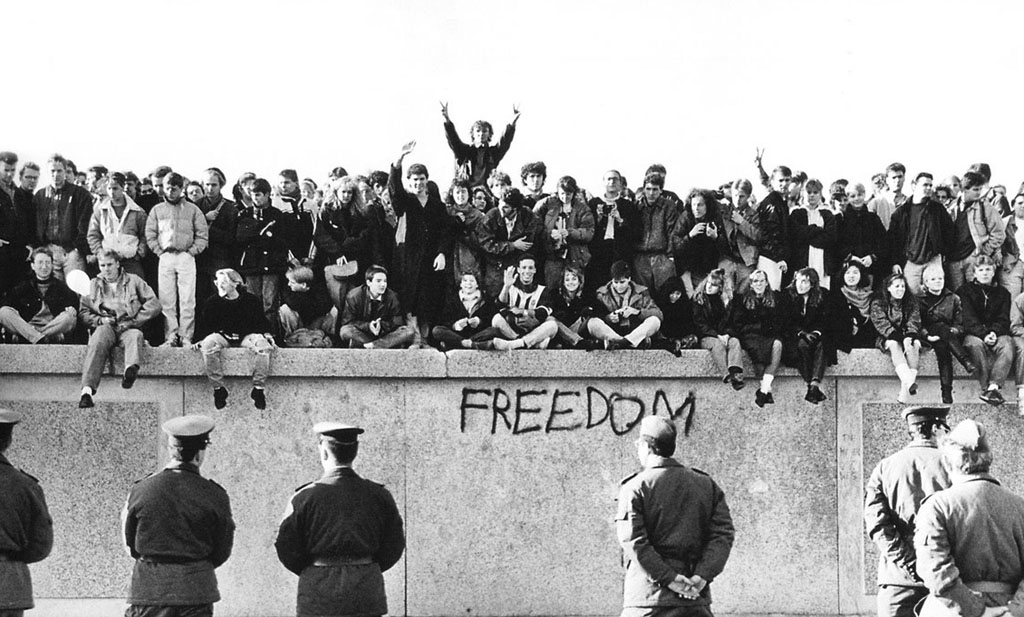02-05-16 // INDEPENDENT URBANISM

East German guards watch the crowds massing on top of the Berlin Wall in 1989. Photograph: GDR Museum
Independent Urbanism
By Bernd Upmeyer
Although the idea that the nation-state as the exclusive agent of connections and relations between political communities is increasingly considered obsolete, the world has witnessed the emergence of more than 30 new countries over the last 3 decades. Especially the fundamental changes in world politics that unfolded across Europe at the end of the 1980s and early 1990s – most emblematically symbolized by the fall of the Berlin wall in November 1989, that led to the dissolution of the USSR and Yugoslavia – caused the creation of most of the newly independent states. Fifteen countries, such as Armenia, Belarus, Estonia, Latvia, Lithuania, Ukraine, or Uzbekistan, to name just a few, became independent with the implosion of the USSR in 1991. Similarly, the former Yugoslavia dissolved into the independent countries of Bosnia and Herzegovina, Croatia, Macedonia, Slovenia, and Serbia and Montenegro, which in turn changed into the State Union of Serbia and Montenegro in 2003, and finally into the separate states of Serbia, Montenegro, and Kosovo (although the independence of the latter has not yet been universally recognized).
However, the creation of independent new countries over the last 3 decades was not limited to the territories of the USSR and Yugoslavia, but occurred in other parts of the world as well, due to a variety of reasons. There is, for example, the case of East Timor, a now sovereign state in Maritime Southeast Asia, achieving independence only in 2002. Some of the fairly new states in Africa include Namibia and the State of Eritrea. But the newest of all the new nation-states is South-Sudan, another African country, having gained its independence from Sudan just a couple of years ago in 2011. Nevertheless, it is quite predictable that South-Sudan will not be the last addition to this list of newly independent nation-states for long, but will most likely be joined by even newer independent countries very soon. Some of the candidates that might soon top this list include Scotland, a Flemish Republic, Catalonia, Veneto, or other regions such as West-Papua in Indonesia.
Reflecting on countries on their way to independence and on the meaning of nation-states is fascinating. However, in this new issue of MONU we neither want to speculate on possible future independent nation-states, nor on those countries that recently gained independence in general, but more specifically contemplate the impact independence has had on their cities and what these cities do with their new-found freedom, what strategies those cities develop to thrive, what potential they have, how they might rise to success, but also what struggles and difficulties they face. All phenomena surrounding cities of countries that recently gained independence we would like to call “Independent Urbanism”. We are especially interested in discovering to what extent these newly “independent” cities, for example, use different methods to overcome their biggest challenges compared to the methods that were used by post-industrial cities of the West, some decades earlier. How are these “independent” cities managed and marketed in a more advanced way than cities in the past, using all the available opportunities and technologies to which cities have access today?
Furthermore, we would like to find out what kind of new urban concepts “independent” cities apply to face up to their social, cultural, political, ecological, spatial, and especially economic challenges? How do they manage, for example, to attract investment or the creative class? How do they deal with urban renewal, provide affordable housing, sufficient schools, infrastructure, and improve the quality of their neighbourhoods and architecture and thus the life of their inhabitants? How do they handle poverty, unemployment, crime and corruption, but also environmental problems? How do they make most of their potential while avoiding a sell-out and loss of identity? How do “independent” cities gain recognition, placing themselves on the map and in the minds of people? What kind of incentives do they initiate to survive? How do they employ the media or events in their development? How do they deal in general with the incredible chance of a fresh start?
Title: Independent Urbanism
Author: Bernd Upmeyer
Date: May 2016
Type: Call For Submissions for MONU
Publications: MONU – Magazine on Urbanism
Location: Rotterdam, The Netherlands